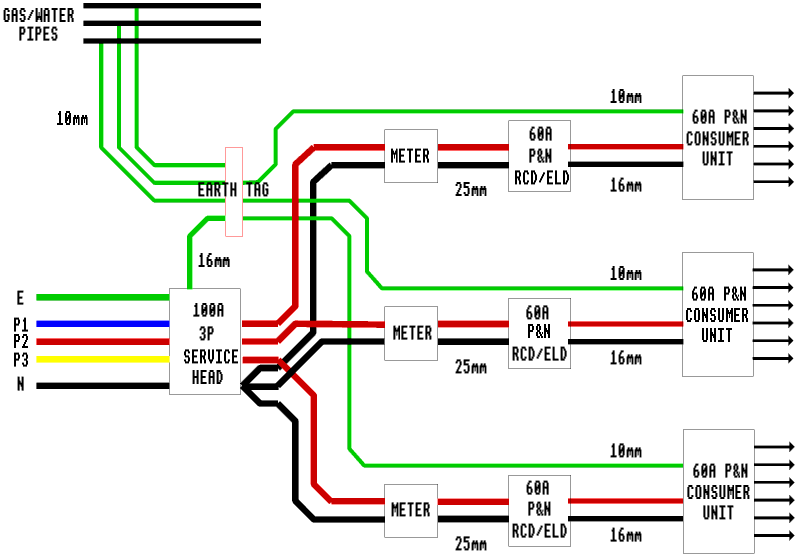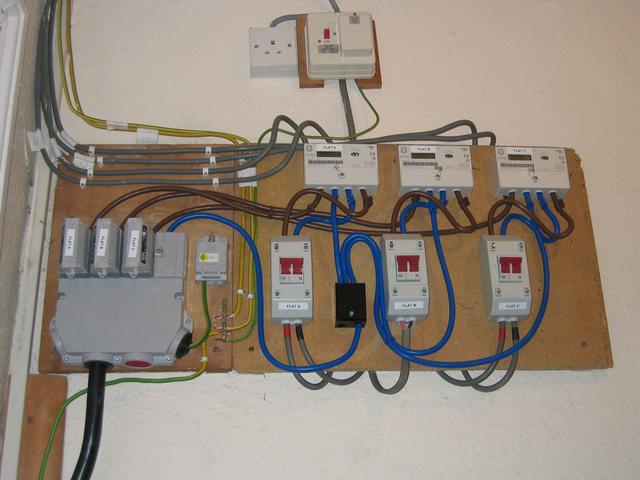
| MDFS::Docs.Electrical.Supply.Multiple.layout/htm | Search |

|
| Supply wiring arrangement to three households |
Summary | |||||||||||||
| 25mm2 supply cable from supply head to meter [Suppliers' requirements, OSG 2.2]
| 25mm2 supply cable from meter to isolation/overcurrent switch [Suppliers' requirements]
| 16mm2 main earthing conductor from supply head to common earthing tag [OSG Table 10A]
| Phase&Neutral Residual Current Detector or Earth Leakage Detector to protect installation [Suppliers' requirements]
| 16mm2 supply cable from isolation/overcurrent switch to consumer unit [OSG Table 6D1, IEE Table 4D1A]
| 10mm2 earth bonding from common earthing tag to consumer units [OSG Table 10A]
| 10mm2 main equipotential conductor from common earthing tag to incoming metallic services [OSG 4.2]
| | ||||||
So, by trawling through the regs, the on-site guide, and pestering the local supplier to prise out required information, this is what I came up with. I hope it can come in useful for anybody else.
The supplier's three-phase cable comes in to the supply head with it's 100A fuse. From there it is broken into three single-phase supplies, with a short length of 25mm2 supply tails connecting to each meter, then some 25mm2 meter tails connecting to each installation's isolation switch. As the consumer unit is "at a distance" from the supply head, a Residual Current Detector or Earth Leakage Detector Phase&Neutral isolation switch is required [Suppliers' requirements, OSG 2.2].
We are aiming to avoid using long, expensive lengths of 25mm2 cables and supply each consumer unit with smaller cables. When using supply cables smaller than 25mm2, you are required to use the next size up from the usual cable size to carry the required current [Supplier's Requirements].

|
| Multiple supply installation The centre supply is actually a Landlord's Supply and just supplies the light and socket seen above the distribution board. |
If the installation required an 80A supply, the Regs tell us that 16mm2 cable has a current carrying capacity of 87A when clipped direct. However, we would need to use the next size up as a supply cable, which puts us back to using the 25mm2 we are trying to avoid.
If the installation is designed to require a 60A supply, the Regs tell us that 10mm2 is rated at 65A when clipped direct. So, we can use the next size up of 16mm2, so avoiding the long, expensive lengths of 25mm2 [OSG Table 6D1, IEE Table 4D1A]. The supply cables then have an installation rating of 65A, as opposed to a manufactured rating of 87A, so they need to be protected by a 60A overcurrent protector. Combined with the requirements due to the consumer unit being at a distance from the supply, this means that each installation needs a 60A P&N RCD or ELD. Note also, that the overcurrent/isolation needs to be "nearby" the supply meter. As a rule of thumb, no more than a couple of feet away.
Earth cable feeding a consumer unit is required to be no smaller than the next size down from the supply cables [OSG Table 10A]. Each installation is fed with 16mm2 cables, so the earth cable can be 10mm2. The bonding cable between the incoming supply and the incoming gas and water pipework has to be at least 10mm2 as normal [OSG 4.2].